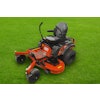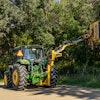
A new construction season is approaching. Or did the last one ever end? Nowadays, projects are more likely than ever to last through the fall and winter, so regular, ongoing maintenance of compact construction equipment is vital.
“Compact construction equipment has advanced over the past 15 years,” says Jason Boerger, senior product manager at Kioti Tractor. “The hydraulics have improved, and there are more specialty attachments that allow digging into frozen ground. Things we couldn’t do 15 years ago are starting to happen year-round.”
Luke Gribble, solutions marketing manager with John Deere’s Construction & Forestry Division, says there often is no offseason for compact construction equipment.
“While some parts of the country may not have as much construction activity in winter months, a growing number of customers are turning to applications like snow removal to keep machines working throughout the year,” Gribble says. “Additionally, agriculture applications and warmer climates require machines to be working year-round.”
That means maintenance of skid-steers, compact track loaders and excavators, wheel loaders, smaller backhoes and other types of compact construction equipment should continue through the fall and winter months and into the spring.
 It's important to ensure equipment is clean. Otherwise, filters, vents and electrical components can become clogged and damaged.Bobcat Co.
It's important to ensure equipment is clean. Otherwise, filters, vents and electrical components can become clogged and damaged.Bobcat Co.
“Maintenance should be prioritized each day,” Gribble says. “In order to keep any machine up and running on the job, it’s best to incorporate a maintenance route and follow best practices to keep it operating for longer.”
Some of that care is generic. For example, Boerger says all machines need thorough inspections of all parts. Look for wear and damage. Keep the components greased and top off the oil, engine coolant and other fluids. The idea is to reduce the risk of downtime.
Boerger advises preparing dormant compact construction equipment for the upcoming season not in the spring but at the end of the previous season.
“One thing commonly overlooked is looking into the operator’s manual for common service intervals,” Boerger says. “Check the recommended service hours for your machine. If you’re close to a service interval and need to do maintenance on a component, or take it to the dealer, it’s a lot easier to do that at the end of your working season than at the beginning of the next season.”
 Regular maintenance intervals can keep equipment in tiptop shape.Bobcat Co.
Regular maintenance intervals can keep equipment in tiptop shape.Bobcat Co.
Cleanliness is another key factor, says Mike Fitzgerald, marketing manager with Bobcat Co., when it comes to skid-steers and compact track loaders. He says neglect in cleaning can cause filters, vents and electrical components to clog or become damaged.
“Regular washing can prevent the buildup of grease and mud,” Fitzgerald says. “Remember, cleaning protects much more valuable aspects of your equipment than its paint job.”
Here are more steps green industry professionals can take to maintain their compact construction equipment:
Keep the fuel tank filled. As temperatures rise and fall, condensation can fill empty space in the fuel tank and mix with the fuel once fuel is added. Filling the tank as the construction season ends keeps condensation out of the tank, Boerger says.
Use the right engine oil. Fitzgerald says the oil viscosity should match the temperature outside. A 10W-30 oil is good for temperatures down to –20 degrees F, but for better cold-weather lubrication and protection in temperatures as low as –40 degrees F, try a 5W-40 synthetic oil.
Charge the battery. Freezing temperatures can force a loader’s battery to crank twice as hard to turn over and deliver fuel to the engine.
“Before the next project or snowfall, run a load test and check wires and connections for wear or corrosion,” Fitzgerald says. “Even a small defect can result in a loss of cranking amps, leaving you with a dead battery and freezing your project.”
 Ensure tracks on each piece of equipment are not too tight or too loose, as this can cause excessive wear and instability, respectively.John Deere
Ensure tracks on each piece of equipment are not too tight or too loose, as this can cause excessive wear and instability, respectively.John Deere
Check the track sag. Gribble says tracks excessively tight can wear down too quickly. If tracks are too loose, they can cause instability in the machine, and the tracks can break loose from the sprocket. Determine the proper track sag by removing all debris between the track and the sprocket, finding the third roller from the rear of the machine and measuring the distance between the bottom of the roller and the top of the track. That distance is the track sag. Consult the operator’s manual for track sag specifications.
Clean the undercarriage. Gribble says the undercarriage is integral to the machine’s mobility and productivity. At the end of each day, check the undercarriage for buildup of material and debris, which can damage components or cause them to freeze.
Fill cold loader tires. Tire pressure drops with the temperature, and cold weather makes the rubber stiffer, so always check that pressure.
“Repair any leaks suffered in the busy season during your regular maintenance schedule,” Fitzgerald says. “A small leak or nail in the tire is easy to put off in warmer weather because you may only have to fill your tire once a week. In winter, once a week can turn into once a day.”
“Stretch” the equipment. Boerger says an athlete wouldn’t compete before stretching. For compact construction equipment, stretching means allowing the machine and its fluids to warm up before use, especially if it hasn’t run for some time.
“It doesn’t mean you have to work slowly the first week; you’ll be able to work the first day,” Boerger says. “It just means with that at the initial startup, you let everything get up to temperature.”
Gribble recommends a warmup period each day and a cooldown period at the end of each shift to protect engine and hydraulic parts.
Ensure the cab is comfortable. Inspect door and window seals to make sure that heat doesn’t escape the cab. Test the heating and defrosting systems.
“Your mom never let you go out into the cold without a stocking cap,” Fitzgerald says. “Smart woman. Freezing temperatures are no time to test your toughness.”
Prepare attachments. Attachments need as much attention as the loader. Inspect the hoses, cylinders and guards, cutting blades and edges for signs of wear or damage.
“If the attachment requires maintenance or lubrication, check the fluid levels before you head out into the cold,” Fitzgerald says. “This is especially important for snow removal attachments that have been collecting dust in your garage since last winter.”
Boerger says routine maintenance of compact construction equipment is one of the best ways to avoid downtime.
“There are no guarantees with equipment downtime, even if you are a careful and thoughtful operator, but routine maintenance reduces your chances of downtime significantly,” Boerger says.













![T708 2025 Ga Tl11 R3 Hr [1 Q5 A1066]](https://img.greenindustrypros.com/mindful/acbm/workspaces/default/uploads/2025/10/t708-2025-ga-tl11r3-hr-1q5a1066.KcuUhTiF78.jpg?ar=16%3A9&auto=format%2Ccompress&fit=crop&h=135&q=70&w=240)






